- Personal or “small necessities” leave is offered by 30% of respondents.
- 99.6% offer 6 or more paid holidays.
- 29.4% allow some form of leave donation or leave sharing.
- Scheduling workloads around leave is the biggest challenge.
Leave Types
| Leave offered | Percent offering |
| 6 or more paid holidays per year | 99.6% |
| Paid vacation time, separately or as PTO | 96.0% |
| Bereavement leave | 84.4% |
| Paid sick leave | 83.2% |
| Paid personal days | 41.5% |
| Extended medical leave | 59.0% |
| Maternity/paternity leave offered separate from other sick leave | 26.6% |
Compensation.BLR.com, now thoroughly reved with easier navigation and more complete compensation information, will tell you what’s being paid right in your state—or even metropolitan area—for hundreds of jobs. Try it at no cost and get a complimentary special report. Read more.
Extended medical leave was a big jump up from 2012, when 27% of participants indicated offering it.
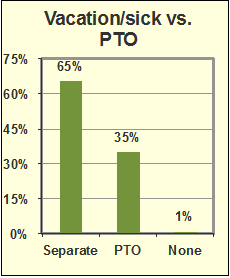
Vacation Offered by Years of Employment
The first year of employment provides 2 weeks of vacation time to both exempt and nonexempt employees for the majority of our survey respondents at 56.4% and 60.2%, respectively (60% and 65% in 2012). One week is offered to exempt employees for 16.9% (20% in 2012) and to nonexempt employees for 22.2% (23% in 2012). Three weeks or more are provided to exempt employees for 19.5%, against 20% last year, and 9.9% offer 3 weeks or more to nonexempt employees, compared to 9% in 2012.
Five years of employment provides exempt employees with 3 weeks of vacation for 52.2% (58% in 2012) of survey participants and 53.6% (62% in 2012) provide nonexempt employees with 3 weeks. Four weeks or more are provided to exempt employees for 20.2% (17% in 2012) and to nonexempt employees for 10.7% (8% in 2012). No vacation is provided to exempt employees for 1.5% of our respondents and 1.7% provide zero vacation to nonexempt employees.
Ten years of employment brings exempt employees 4 weeks of vacation for 41.2% and brings nonexempt employees the same for 37.7%, against 37% for both last year. Five weeks or more are provided to exempt employees for 10.2% (12% in 2012) and to nonexempt employees for 7.7% (7% in 2012).
Fifteen years of employment brings 4 weeks of vacation to 50% of responding employers for both exempt and nonexempt employees; 3 weeks for exempts for 20% of respondents and for nonexempts for 22% of respondents. Five weeks of vacation are available for exempts for 14.7% of respondents and for nonexempts for 12% of respondents.
Sick Time
One-half to 1 day per month is the amount of sick leave accrued by exempt employees for 36.9% (38% in 2012) of our respondents who offer this benefit and nonexempt employees accrue the same for 37% (41% in 2012).
Exempt employees accrue 1 week or less per year for 21.2% (24% in 2012) of survey participants and nonexempt employees accrue the same for 21.3% (24% in 2012).
Exempt employees accrue 2 weeks per year for 14.6% (14% in 2012) and nonexempt employees accrue that amount for 13.9% (13% in 2012). Three weeks per year are accrued by exempt employees for 4.3% and by nonexempt employees for 3.8% (both 3% in 2012). Four weeks or more are accrued annually by exempt employees for 3.9% (4% in 2012) and by 2.4% (2.5% in 2012) for nonexempt employees
Employees may use sick time to care for a dependent for 80.3% of those who answered this question and, of this group, 95% allow its use to care for a sick child, while 91.6% allow use of employee sick time to care for a spouse. It starts to drop when employees need time off to care for a parent (79.5%) and continues to decline when employees need to care for a sibling or grandparent (40.4% and 41.1%, respectively).
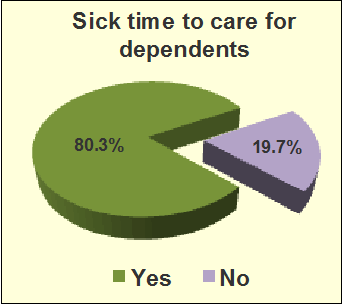
Disability Leave
Paid short-term disability (STD) leave of less than 30 days is an option for 11.7% of survey participants who responded to this question. STD leave of 31 to 90 days is available to 42.6% and 91 to 180 days is allowed for 40%. When it comes to how much of STD leave is paid, 59.6% cover 51% to 75% of employees’ base pay and 20.4% cover 76% to 100%.
Paid long-term disability (LTD) leave of more than a year is available for 51.3% of survey participants who answered this question. LTD of 6 months to a year is an option for 17.8% and 4 to 6 months of paid LTD is available for 11.9%, while 2 to 4 months is a benefit for 11.2%. LTD pay covers 51% to 70% of base pay for 75.1% and 26% to 50% of base pay for 11.9%.

Paid Time Off (PTO)
The first year of employment provides 2 weeks of PTO to exempt employees for 19.2% (31% in 2012) of those who offer this benefit and nonexempt employees receive the same for 20.6% (32% in 2012) of our survey respondents. One week is offered to exempt employees for 9.6% (11% in 2012) and to nonexempt employees for 11.9% (15% in 2012). Three weeks or more are offered by 30.8% to exempt employees and 25.9% offer 3 weeks or more to nonexempt employees.
Five years of employment provides exempt employees with 3 weeks of PTO for 18.2% (33% in 2012) of survey participants and 19.6% (32% in 2012) provide nonexempt employees with 3 weeks. Four weeks or more are provided to exempt employees for 31.2% (57% in 2012) and to nonexempt employees for 26.9% (54% in 2012). No PTO is provided to exempt employees for 35.8% (0.5% in 2012) of our respondents and 35.7% (2.5% in 2012) provide zero PTO to nonexempt employees.
Ten years of employment brings 4 weeks of PTO to exempt employees for 18.3% (38% in 2012) and the same to nonexempt employees for 18% (39% in 2012) of those who responded to this question in our survey. Five weeks or more are provided to exempt employees for 26% (44% in 2012) and to nonexempt employees for 23% (40% in 2012).
Personal Leave
Sometimes called small necessities leave, personal days are offered by 30% of our survey participants, with 69.2% of them offering 1 to 3 days annually and 18.2% offering 4 to 5 days.
Bereavement Leave
Bereavement leave is offered by 80% of respondents.
Time off for the funeral of a spouse, child, or parent is available for 99% of those who offer bereavement leave as a benefit. Brother and sister are included for 95.9%. Grandparents are included for 88.5% and grandchild is included for 79.3%. Stepparent and stepchild are included for 75.3% and 77.4%, respectively.
Bereavement leave for the death of an employee’s mother-in-law or father-in-law is included for 81%. Leave for the funeral of a brother- or sister-in-law, though, is available for 58.4% (down from 60% in 2012). Extended family members are included for 24.4% and exes and their family members are included for 4.6% and 3.9%, respectively.
“Other” covers 11.7% of responses for an eclectic mix that includes significant other, registered domestic partner, legal guardian, close friend, girlfriend or boyfriend, any relative who has ever lived with you, and pets.
Military Leave—Full Pay for 13.5%
Employees on military leave receive their full pay in addition to any military pay they receive for 13.5% (11.5% in 2012) of the participants who responded to this question in our survey. The difference between full pay and military pay is available for 35.5% (19% in 2012) and 2.8% (1.5% in 2012) offer partial pay in addition to employees’ military pay. No paid military leave is available for 40.9% (53% in 2012).
Jury Duty—Virtually All Pay
Of those who offer PTO for jury duty, 45.8% offer full pay less any jury duty pay employees receive from the court system and 43.6% provide full pay in addition to pay received from the court.
Voting Leave
State law requires 22% of our survey respondents to provide PTO for voting and another 14.1% provide it even though it’s not required by their state. Unpaid time off to vote is offered by 33.4% and 25% require employees to vote outside their business hours. “Other” accounts for the remaining 5.4% with responses such as:
- Must use PTO time.
- Election Day is a paid holiday.
- Absentee ballots are encouraged.
- Employees can use flextime.
- Voting is by mail.
Leave Practices
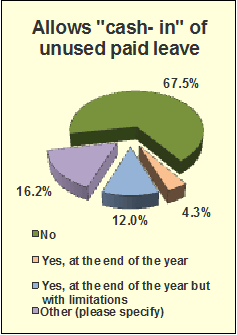
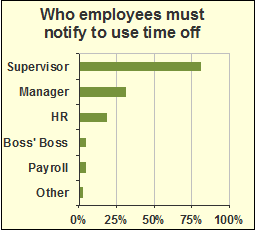
Deducting from Exempt Employees
When asked whether they deduct from exempt employees’ accrued leave to cover partial-day absences, 35.9% of survey participants who answered the question indicated they do not. For 14.9%, however, the answer was yes, with the amount of time depending on the situation. Deductions in half-day increments are made for 22.7% and 8.4% deduct in hourly increments. Half-hour deductions are allowed for 5.5% and 8% deduct quarter hours. “Other,” though only 4.9% of the responses for this question, provided a mixed bag, with some interesting responses, including: “If you work 4.5 hours/day, you can leave without using PTO,” “Depends on the reason,” and “Only if the exempt employee is not going to be available to be reached.”
Leave Rollover Allowed?
Use it or lose it is the rule of thumb for 18.5% and, though they can’t roll it over, 3.3% reimburse employees for all or part of their unused paid leave. Roll over of all or a portion of unused paid leave time from one year to the next, however, is an option for 70.8% of survey respondents. “Other,” at 7.5%, once again provides a few interesting answers, including: “Any unused PTO is rolled into a medical reserve bank,” “No, except in California,” and “We have unlimited PTO so there are no hours to roll over.”
Leave Paid Out at Departure
When asked which types of leave survey respondents pay out to employees when they leave the company, 60.2% pay for vacation, 9.3% pay out sick time, 32.4% pay out any unused PTO, and 7.6% don’t pay cash for unused paid leave.
Donating Leave
While 29.4% (25% in 2012) of survey participants allow some degree of leave sharing or donating, no sharing paid leave between employees is the rule for 54.7% (56% in 2012) of survey participants. This issue has never been addressed by 13.5% (17% in 2012).
FMLA Notification and Tracking
For 81.1% of survey participants who answered the question, employees are required to notify HR when requesting FMLA leave and 85.3% also require employees to notify their supervisor or manager. When it comes to use of intermittent FMLA leave, however, 71.1% require notification to HR and 92.1% require employees to notify their management. HR is responsible for tracking FMLA at 80.6% and supervisors or managers are responsible at 4.5%.
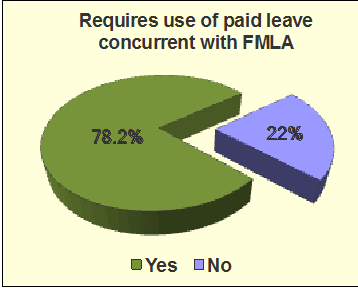
Challenges
When asked to indicate their top challenges regarding employee leave, scheduling workloads around employee leave topped the list at 47%. Recordkeeping and/or tracking leave at 38.9% and abuse of leave at 37.7% came in second and third, respectively. FMLA intermittent leave came in fourth at 33.2% and consistent application of leave policies was fifth at 27.1%.
Demographics of the 3,706 Participants
A total of 3,706 individuals participated in this survey, which was conducted in September 2013. Of those who identified themselves, 55.7% represent privately owned companies, 10.3% are with public entities, and 31.6% work for government or nonprofit organizations.
| Number of Employees | Percent of Respondents |
| 1-250 employees | 58.8% |
| 251-500 | 13.5% |
| 501-1,000 | 9.8% |
| more than 1,000 employees | 17.9% |
Fewer than 8% of the employers surveyed have a 50% to 100% unionized workforce; 86.1% have a workforce that is less than 10% union employees. Fewer than 28% of the respondents have a workforce of more than 50% exempt employees.
Over half (67.5%) of the participants are in service industries; 19.7% are in agriculture, forestry, construction, manufacturing, or mining; 8% are in wholesale, retail, transportation, or warehousing; and 4.9% are in real estate or utilities.
